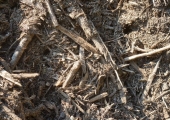




 3
3




A human being should be able to change a diaper, plan an invasion, butcher a hog, conn a ship, design a building, write a sonnet, balance accounts, build a wall, set a bone, comfort the dying, take orders, give orders, cooperate, act alone, solve equations, analyze a new problem, pitch manure, program a computer, cook a tasty meal, fight efficiently, die gallantly. Specialization is for insects.
-Robert A. Heinlein
 1
1




"Study books and observe nature; if they do not agree, throw away the books." ~ William A. Albrecht




http://www.popcliq.com (web development), GoPermaculture Food Forest http://www.permies.com/t/57687/forest-garden/Permaculture-Food-Forest-suburban-permaculture, Sea Buckthorn (Seaberry) grower (hobbiest) https://www.facebook.com/michelle.bisson.37, zone 3b/4b (borderline) Quebec Canada




Idle dreamer




1. Applying a layer of store bought bark mulch on walking areas,
2. Applying a layer of leaves on growing areas,
It is hard to have enough quantities to compare with bags of leaves, but if you have them, then use them in the garden or compost them. A variety of bio mass is good.3. Throwing some coffee grinds all over the garden, and
4. Interplanting some nitrogen fixers with my vegetable crops?
http://www.popcliq.com (web development), GoPermaculture Food Forest http://www.permies.com/t/57687/forest-garden/Permaculture-Food-Forest-suburban-permaculture, Sea Buckthorn (Seaberry) grower (hobbiest) https://www.facebook.com/michelle.bisson.37, zone 3b/4b (borderline) Quebec Canada




 1
1




http://www.popcliq.com (web development), GoPermaculture Food Forest http://www.permies.com/t/57687/forest-garden/Permaculture-Food-Forest-suburban-permaculture, Sea Buckthorn (Seaberry) grower (hobbiest) https://www.facebook.com/michelle.bisson.37, zone 3b/4b (borderline) Quebec Canada
 1
1




"The rule of no realm is mine. But all worthy things that are in peril as the world now stands, these are my care. And for my part, I shall not wholly fail in my task if anything that passes through this night can still grow fairer or bear fruit and flower again in days to come. For I too am a steward. Did you not know?" Gandolf
 1
1




Michelle Bisson wrote:I used shavings and they do not blow about in the wind like loose dry leaves. They interlock and form a mat which makes for good walkway mulching material. I found that the fine shavings are less ideal for a mulch for the garden (unless mixed with bulkier material) since they form this mat and then the rains have a harder time penetrating and runs off. Mulches should be loose and bulkier to allow rain to penetrate and not run off.

 2
2




List of Bryant RedHawk's Epic Soil Series Threads We love visitors, that's why we live in a secluded cabin deep in the woods. "Buzzard's Roost (Asnikiye Heca) Farm." Promoting permaculture to save our planet.




Bryant RedHawk wrote:Have you looked through My soil threads? you might find more ideas there.
Redhawk

|
Let me tell ya a story about a man named Jed. Poor mountain man with a tiny ad:
Support permies and give beautiful gifts to gardeners: permaculture playing cards.
https://gardener-gift.com/
|






